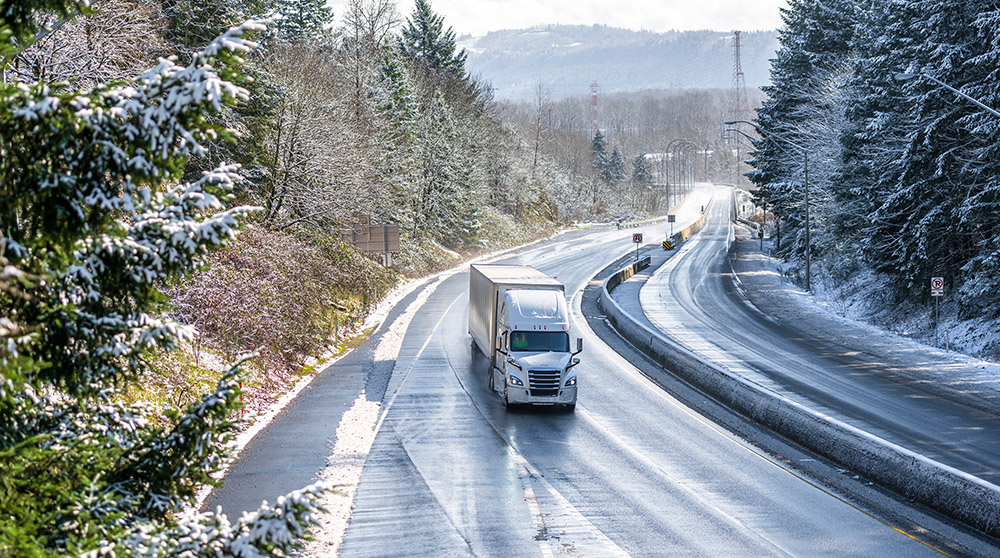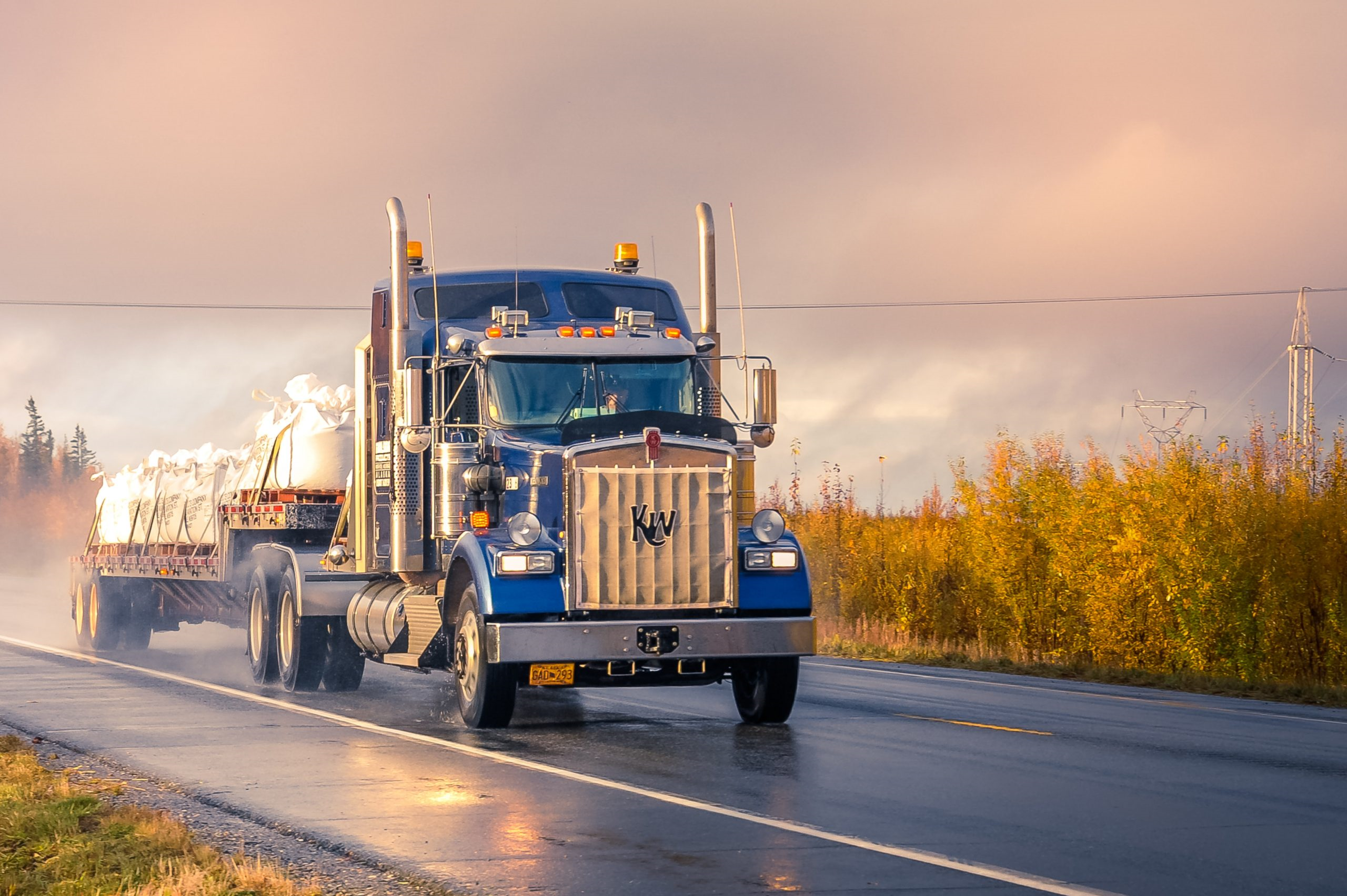Keeping your drivers safe on the road isn’t just essential for their health and well-being. Their safety directly impacts other motorists on the road, as well as your bottom line. The Department of Labor (DOL) singles out trucking as one of the most dangerous occupations in the United States. In fact, transportation and logistics fleets have some of the highest numbers of injuries and fatalities on the job—and those numbers seem to only grow year over year. By improving the safety of your drivers, you not only ensure their protection, but you can also reduce costs associated with accidents, claim payouts, and rises in insurance premiums. The good news is that you can improve your truck drivers’ safety by creating a work culture that actively coaches, trains, and rewards the safest drivers. Read on for our best truck driving tips and advice on how to improve the overall safety of your fleet.
1. Encourage your truckers to practice defensive driving
Defensive driving is a form of driving that encourages truckers to consistently be on the lookout for potential hazards and changes in driving or road conditions. Drivers are encouraged to reduce the risk of accidents and injuries by anticipating potentially dangerous situations and making safe, well-informed decisions while behind the wheel. By using defensive driving techniques, drivers are less likely to be involved in accidents—so you can worry less about costly repairs, claim payouts, and insurance premiums increases.
Here are a few key defensive driving strategies and practices to encourage your drivers to use:
Watch out for blind spots: For drivers who operate tractor trailers or refers, being in such a large truck that’s so high off the ground can make it difficult to see cars behind or even next to their vehicle. A blind spot is any area around a vehicle that cannot be directly seen by a driver. According to the National Highway Traffic Safety Administration (NHTSA), over 840,000 accidents per year are directly due to blind spots. Most of these accidents occur when drivers are changing lanes. Since rear-view and side mirrors aren’t always effective when checking for blind spots, make sure you’re encouraging drivers to look over their shoulders and out the windows when changing lanes. Also, encourage them to leave plenty of room around their vehicles when merging.
Practice the three-second rule: When it comes to avoiding forward and rear collisions, a best practice is for drivers to follow the three-second rule. This rule states that truck drivers should allow three full seconds to pass between the time the car in front of them reaches a particular spot on the road and the time it takes the truck driver to reach that same point. If heavy rain or winds are present, drivers should increase the follow time to five seconds. If the roads are icy, drivers should increase the follow time to 10 seconds.
Be prepared for emergencies: When driving, especially over long distances, conditions can rapidly change. Encourage your drivers to be prepared for a variety of potential emergency situations—like bad driving conditions or breakdowns. Drivers who stock their cabs with water, snacks, a first aid kit, a change of clothes, and blankets can comfortably and safely weather unexpected conditions that may require them to pull off the road or wait long periods for vehicle repairs.
Stay calm, cool, and collected: Road rage is a serious threat to safe driving. When truckers are cut off, honked at, or otherwise harrassed by other drivers, it can be tempting to indulge in road rage behaviors, like tailgating or weaving between lanes. Drivers who allow their anger to control their driving put themselves and others at risk for accidents. Encourage your drivers to de-escalate road rage situations by increasing the distance between themselves and angry drivers.
Always signal: For drivers who operate on longer stretches of roads or during non-peak traffic times, it can be tempting to complete lane changes and exit highways without signaling. But failing to signal can increase the likelihood of collisions. Remind drivers that signaling before changing lanes or turning is required by law, and they should still signal even if they don’t see any other vehicles nearby.
When in doubt, slow down: Train your drivers to always default to slowing down in response to changes on the road, including bad weather or poor visibility. Slowing down offers drivers extra time to take corrective action or respond to sudden changes, like an animal running onto the highway or slippery roads when it starts to rain. Slowing down can prevent accidents altogether or, at the very least, decrease the impact and severity if an accident does occur.
2. Develop preventative maintenance schedules
The safety of your drivers really starts with the safety of the vehicles they’re in. Trucks and tractor trailers that aren’t up-to-date with their regular maintenance—like oil and brake pad changes—are more likely to break down on the road. Telematics devices, like Samsara’s Vehicle Gateway (VGs), offer real-time visibility into odometer and engine data, including fault codes.
Using this data, your mechanics can build out robust preventative maintenance schedules based on mileage, days, previous breakdown history, and more—plus get real-time alerts for critical fault codes. Through regular upkeep and proactive repairs, you can ensure your vehicles are in top shape so drivers can avoid breakdowns on their routes.
3. Ensure comprehensive pre-trip and post-trip inspections
Hand-in-hand with increasing driver safety through maintenance is using thorough vehicle inspections to ensure all trucks are safe before drivers start driving. While pre-trip and post-trip inspections are required by the DOT, not just any inspection will do. To protect the safety of your drivers, use tools that ensure all inspections are thorough and accurately documented.
The Samsara Driver App, for example, allows drivers to submit electronic DVIRs directly from their phone. Our app walks drivers through every part of the inspection and allows them to upload photographs of any vehicle issues. This ensures that every inspection is thorough. And if an unsafe DVIR is submitted, your management team can be notified in real time, so they can arrange repairs to ensure your drivers are safe.
4. Coach drivers to avoid distractions
The Federal Motor Carrier Safety Administration (FMCSA) has identified distracted driving as the number one cause of accidents for truck drivers. Distracted driving is anything that causes a driver to take their eyes off the road or their hands off the steering wheel. Distractions can range from eating lunch while driving to turning out the window to stare at a billboard. But the most common form of distracted driving is cellphone usage, in particular texting while driving.
If your vehicles are equipped with dual-facing dash cams that have artificial intelligence (AI) built in, like Samsara AI dash cams, the camera can identify when a driver is distracted based on their head position (like if they’re looking down at their smartphone). Using this footage, you can coach drivers on how to correct their behaviors to avoid distractions and reduce their likelihood of causing an accident.
5. Have tools in place to respond to changes in road conditions
Road conditions can be unpredictable, especially for long-haul drivers working long hours across many regions or states. The two conditions most likely to impact the safety of drivers on the road are traffic and bad weather. Bumper-to-bumper traffic causes vehicles to constantly stop and go, which increases the likelihood of accidents. And bad weather conditions—like snow, ice, hail, or rain—can impact a driver’s visibility or can cause roads to become slippery, all of which contribute to a greater chance of an accident.
Dispatch management solutions, like Samsara, provide live weather and traffic map overlays that allow your dispatchers to see where road conditions may be unsafe for your drivers. With Samsara, your dispatchers can easily reroute drivers to avoid bad conditions and can directly send drivers their updated routes through our Driver App—which eliminates the need for manual back-and-forth calling.
6. Watch over your fleet with real-time GPS tracking
With a fleet management platform, like Samsara, that provides real-time GPS tracking you can always know the exact location of all your drivers. Real-time GPS is essential for ensuring the safety of your drivers, especially during breakdowns or other emergency situations. If a vehicle breaks down, it’s essential that you know its precise location so you’re able to assist the driver as soon as possible.
By knowing a driver’s exact location, you can either easily reroute them to the closest shop for a repair or can send a maintenance crew or tow truck directly to them. This ability to quickly and accurately respond to breakdowns means that you can reduce downtime and get your fleet back to work. Also, drivers won’t have to wait long hours off the side of the road, which can potentially put them at risk for collisions.
7. Encourage proper rest and breaks
Under HOS regulations, all drivers of commercial motor vehicles (CMVs) are required to take certain breaks before they can continue driving. For instance, under HOS truck driver limits, all CMV drivers must take a 30-minute break after eight hours of driving and a 10 to 11 hour break before coming back on duty.
Outside of taking these mandatory breaks, encourage drivers to always prioritize their safety and the safety of other motorists while on the road. This means encouraging your drivers to take additional breaks while en route if they are feeling sleepy or impaired in any way. Although this may require additional time taken out of their “On-Duty” period, it could play a significant part in reducing at-fault accidents due to fatigue. This not only keeps your drivers safer but helps you reduce accident-related costs.
8. Build out coaching and rewards programs with dash cams
An important part of building a safety-first culture is incentivizing and rewarding drivers who embody good driving habits and practices. One of the easiest ways to ensure safety in your fleet is through building out coaching and rewards programs. By introducing dash cams to your fleet, you can use real footage to actually show drivers how to improve their safety on the road.
Samsara’s dual-facing AI dash cams capture both external and in-cab footage. Plus, they integrate with our Vehicle Gateway, so it’s easy to detect when a driver brakes too hard, accelerates too fast, or turns too harshly. When one of these events is detected, you can receive a text or email notification. In that notification, you’ll have immediate access to footage of the event. You can review this footage with drivers to coach them on safer driving practices. And for on-the-go training, our dual-facing dash cams offer optional in-cab audio alerts for speeding and more, so you can minimize risk in real time.
With Samsara, you can track how your drivers’ safety is improving over time. Plus, every driver can see a safety score based on harsh events, miles driven, speeding, and more. Your fleet can use these scores to gamify safety by offering drivers with the highest score a reward. Our customers have offered everything from special plaques to the best parking spot to reward their safest drivers. But mostly it’s just the sheer recognition, not the reward, that counts.


